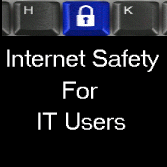
This course is designed to enable you to make safe and legal use of the Internet. It will provide you with information about the safety factors and legal considerations which need to be taken into account when using the Internet, and give you practical experience in taking safety precautions and operating within legal constraints.
The content includes dealing with unwanted e-mail, protecting against identity theft and protecting systems against viruses and other threats. The course is suitable for a wide range of candidates and is particularly appropriate for Teachers, young people, parents and mature Internet users.
No previous knowledge or experience of computers or the Internet is required. However, it would be advantageous if you possessed basic IT skills.
Internet safety is about the safe and legal use of the Internet. The Internet is used by lots of people – of all ages – for lots of purposes, ranging from chatting to friends to booking a holiday – and the use of the ‘Net is growing at a rapid pace. But there are risks involved in using the Internet. These risks include:
unwanted e-mail,
online fraud,
identity theft,
child grooming and
viruses.
There are numerous media reports about abuses. And new threats are emerging all of the time. A large survey carried out by Ofcom highlighted these two trends;
growing use of the Internet, accompanied by increased threats to personal safety
and emphasised the lack of awareness about potential threats.
So Internet safety means knowing about potential threats when you are online; knowing what you can and cannot (legally) do when you are online; and knowing how to protect yourself from some of the risks that are involved in using the ‘Net.
In a recent survey over 90% of teachers reported an interest in offering a qualification in Internet Safety. The survey made two things clear:
(1)Teachers and lecturers were concerned about Internet safety; and
(2) most centres only offered ad hoc advice to pupils and students on how to protect themselves.
So it was felt that a qualification would formalise the approach to Internet safety and standardise the advice given to students. And since it’s a National Qualification, it may qualify for funding.
We think that it’s the first national qualification in Internet safety in the world. We’re hoping that it will appeal to both UK and international students and make a contribution to improving the safety of Internet users of all ages everywhere.
The qualification is very straight-forward. It consists of a single National Unit at SCQF level 4 (Intermediate 1). The unit is entitled: “Internet Safety”. There are four outcomes in the Unit:
Identify threats that can exist when using the Internet.
Describe safety precautions which should be taken when using the Internet.
Describe legal constraints which apply when using the Internet.
Take appropriate safety precautions and operate within relevant legal constraints when using the Internet.
The threats covered include identity theft, cyber-bullying, grooming, phishing and pharming (Outcome 1). Advice is provided on how best to combat these threats (Outcome 2) such as how to set-up virus protection and firewalls, and how to recognise an online scam.
The unit also explains your legal responsibilities when using the Internet (Outcome 3) and discusses issues such as copyright restrictions on downloading music. The final outcome puts all of this into practice by ensuring that students can actually take precautions and work safely online.
The unit should be of interest to anyone who uses the Internet. Although much of the media focus is on young people, mature users are just as likely to experience problems. So the unit is designed for school pupils, college students, adults who work with children, people who shop online, and “silver surfers”.
It is expected that the unit will also be of particular interest to practicing teachers and librarians who may want to know more about the potential dangers facing young people in their charge.
Assessment
An integrative approach has been taken with the four outcomes being assessed through two instruments of assessment. The first assessment covers Outcomes 1, 2 and 3, and the second assessment relates to Outcome 4.
The assessment for Outcomes 1, 2 and 3 is an assessment consisting of 25 multiple choice questions which assess candidates’ knowledge and understanding. It is expected that this assessment will be carried out towards the end of the unit once candidates have had an opportunity to acquire the essential knowledge and understanding required to give them a realistic prospect to pass the assessment.
The assessment for Outcome 4 is a practical assessment consisting of observation of the candidate over an extended period of time during which the candidate is required to maintain a log of activity.
If you haven't registered to take this course yet go to this page and select Internet Safety to join now.
Already joined? Go here to get started
Leave a Reply